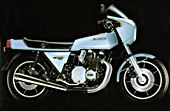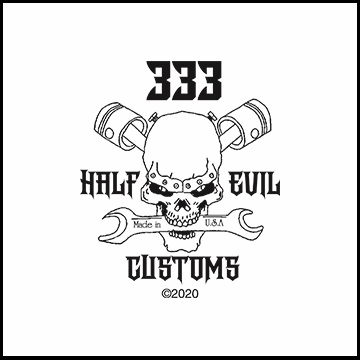
By 1978, Kawasaki�realized�its once-mighty Z bikes were getting a bit long in the tooth. The Z concept needed some sprucing up, so Kawasaki created the KZ1000-D1, better known as the Z1-R, a factory cafe racer. Mechanically, nor much differed from the standard KZ1000: Carbs grew by a couple of millimeters, a four-into-one exhaust replaced the standard four-into-two unit, the frame was stiffened a bit, the rear shocks were firmed up, the triple-disc brakes were drilled for that Superbike look, and seven-spoke cast wheels replaced the standard wire units. All this resulted in minor improvements in straight-line performance and handling.
What distinguished the Z1-R was its handlebar-mounted quarter fairing, the first to appear as standard equipment on a Japanese bike. In addition to being the first standard-fitment fairing from Japan, Kawasaki's unit gave the folks at Kawasaki Heavy Industries space to mount a few additional gauges. With its relatively rail windscreen, the fairing even afforded decent wind protection. While the angular styling then in vogue may not have the same aesthetic appeal today, the Z1-R certainly caused a stir back in the day.
At least in the enthusiast magazines, that is. The motorcycle-buying public greeted the Z1-R with a group yawn, ignoring it for the more chopperesque LTD models. While this may seem backwards today, remember that American tastes were very different a quarter of a century ago--just look at the hairstyles of the day. So the Z1-R languished on the showroom floor, and as a result there aren't a lot of them for sale today. And while dealers were giving them away at fire-sale prices back in the early '80s, if you find one today, chances are you're going to part with a considerable amount of cash to bring it home.
If you do find a dean one, make certain that it's cosmetically complete and in good shape. Finding original fairings, sidecovers and pipes is nearly impossible. If it's nor dean and complete, it is really worth no more than any other old Kawasaki Z bike. The most likely piece to be missing on a bike that hasn't been crashed is the original pipe, since it will have rusted out unless the bike has been stored properly if the pipe has been replaced with a set of the headers common m the late '70s and early '80s, watch for a leaky head gasket. Otherwise, there isn't a lot that goes wrong with early Z bikes.
Source: Motorcyclist, 11/01/2000, written by Darwin Holmstrom

| Identification | � | � |
| �Letter designation | � | �D1 |
| �Color� | � | �Metallic stardust silver |
| �Frame # | � | �KZT00D-000001 - 017392 |
| �Engine # | � | �KZT00DE-000001 - 017412 |
| � | � | � |
| Dimensions | � | � |
|
�Overall length |
� | � |
|
�Overall width |
� | � |
|
�Overall height |
� | � |
| �Wheelbase | � | � |
| �Road clearance | � | � |
| �Dry weight | � | �246 kg |
| �Fuel tank capacity | � | �13 l |
| � | � | � |
| Performance� | � | � |
| �Climbing ability | � | � |
| �Braking distance | � | � |
| �Minimum turning radius | � | � |
| � | � | � |
| Engine� | � | � |
| �Type | � | �4 stroke, DOHC, 4 cylinder, air cooled� |
| �Bore and stroke | � | �70 mm�x 66 mm |
| �Displacement | � | �1015 cc |
| �Compression ratio | � | �8.7 |
| �Maximum horsepower | � | �90 hp @ 8,000 rpm |
| �Maximum torque | � | �8.7 kg-m @ 7,000 rpm |
| �Valve timing | � | � |
|
Open Closed Duration� |
|
|
Open Closed Duration� |
|
| �Carburetors | � | �(4) Mikuni VM28SS |
| �Lubrication system | � | �Wet sump |
| �Engine oil | Type� | �SAE 10W40, 10W50, 20W40, 20W50 |
| � | Capacity | �3.7 l |
| �Starting system | � | �Electric starter and kick |
| �Ignition system | � | �Battery and coil (transistorized) |
| �Cylinder numbering method | � | �Left to right, 1-2-3-4 |
| �Firing order | � | �1-2-4-3 |
| �Ignition timing | � | � |
| �Spark plugs | � | �NGK B8ES or ND W24ES-U |
| � | � | � |
| Transmission� | � | � |
| �Type | � | �5 speed, constant mesh, return shift |
| �Clutch | � | �Multi-disc, wet |
| �Gear ratio | 1st� | � |
| � | 2nd | � |
| � | 3rd | � |
| � | 4th� | � |
| � | 5th� | � |
| � | 6th� | �- |
| �Primary reduction ratio | � | � |
| �Final reduction ratio | � | � |
| �Overall drive ratio | � | � |
| � | � | |
| Electrical equipment� | � | � |
| �Alternator | � | � |
| �Regulator/rectifier | � | � |
| �Ignition coils | � | � |
| �Battery | � | � |
| �Starter motor | � | � |
| �Headlight | Type� | � |
| � | Bulb� | � |
| �Tail/brake light | � | � |
| �City light | � | � |
| �Turn signal lights | � | � |
| �Meter lights | � | � |
| �Indicator lights | � | � |
| �Horn | � | � |
| � | � | � |
| Frame� | � | � |
| �Type | � | �Tubular, double cradle |
| �Steering angle | � | � |
| �Castor | � | � |
| �Trail | � | � |
| �Tire size | Front� | �3.50 - 19 |
| � | Rear� | �4.00 - 18 |
| �Suspension | Front� | �Telescopic fork |
| � | Rear� | �Swing arm |
| �Suspension stroke | Front� | � |
| � | Rear� | � |
| �Front fork oil | Type� | � |
| � | Capacity� | � |
| � | Oil level� | � |
| � | � | � |
| Brakes� | � | � |
| �Type | Front� | �Dual�disc |
| � | Rear� | �Single disc |
| �Effective disc diameter | Front� | �298 mm |
| � | Rear� | � |



